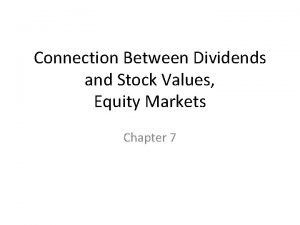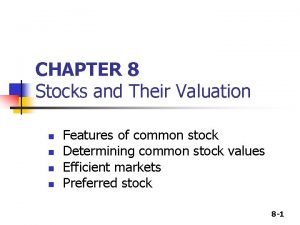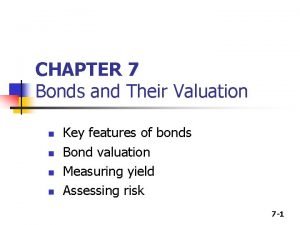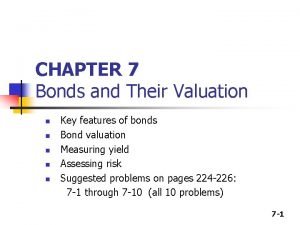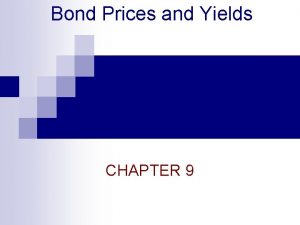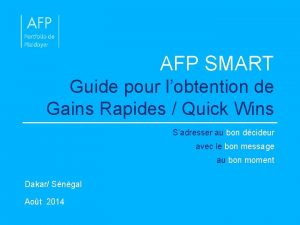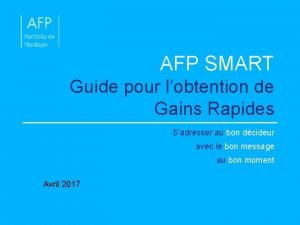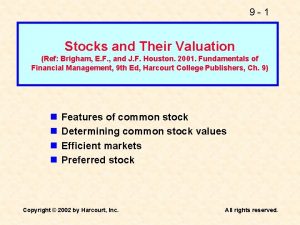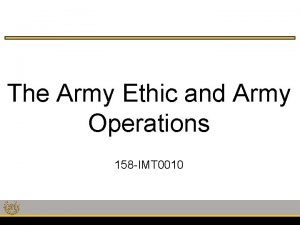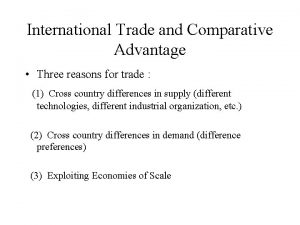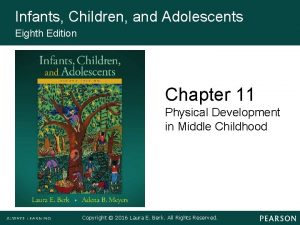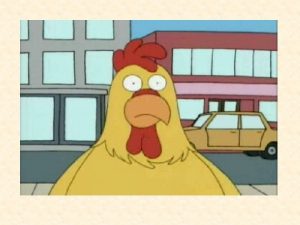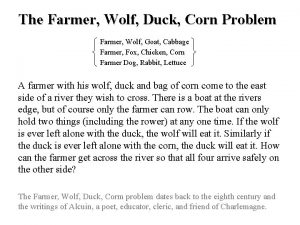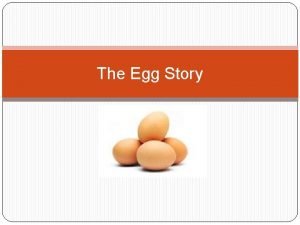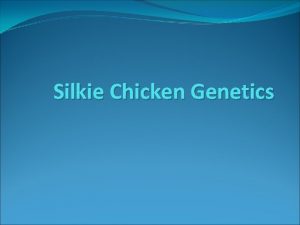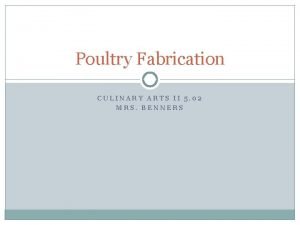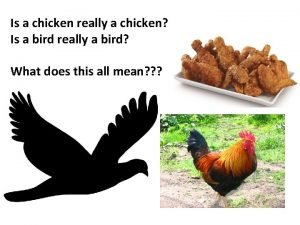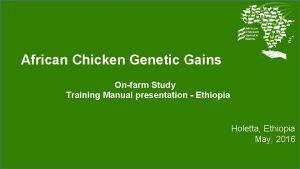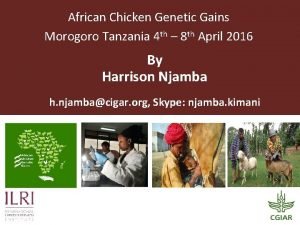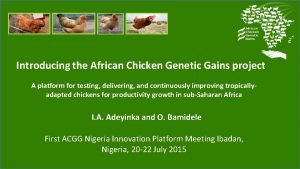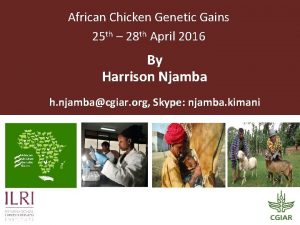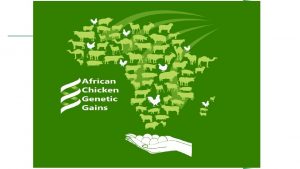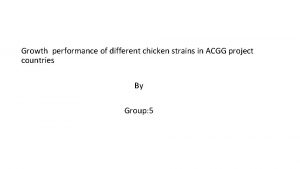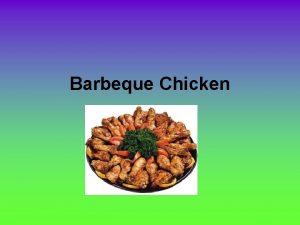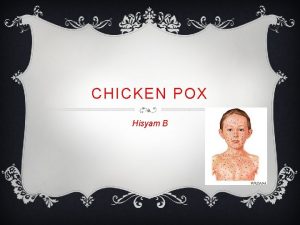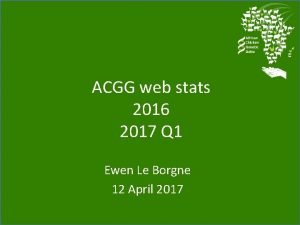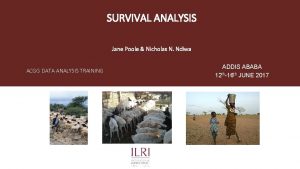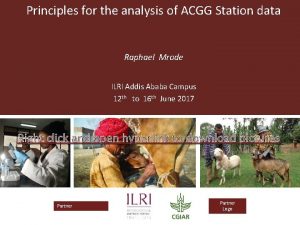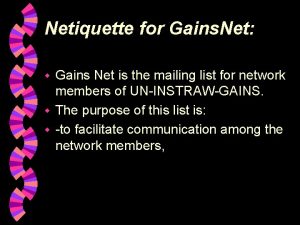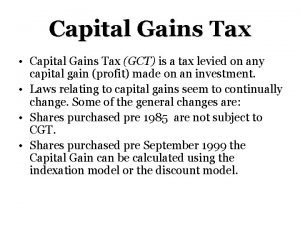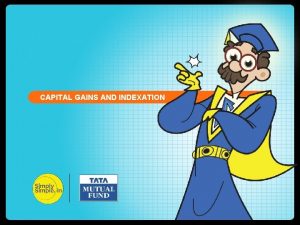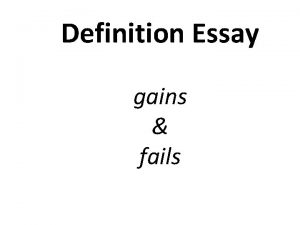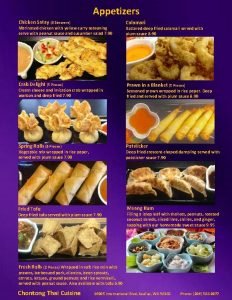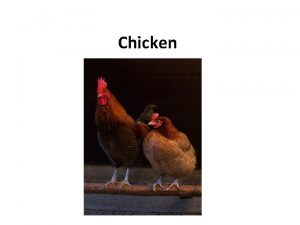African Chicken Genetic Gains ACGG Onfarm Study Training







































![Frequency: week 12 [Birds approximately 18 weeks of age] then Egg production every 2 Frequency: week 12 [Birds approximately 18 weeks of age] then Egg production every 2](https://slidetodoc.com/presentation_image/bf5284f5416b79c748424ed60b4ac3ae/image-40.jpg)







- Slides: 47

African Chicken Genetic Gains ACGG – On-farm Study Training Manual presentation - Nigeria ILE-IFE, Nigeria April, 2016

Plan for this week • Learn procedures for undertaking the on-farm chicken performance evaluation including the experimental design, data collection, feeding and management standards; • Discussions on farmer recruitment, obtaining consent, dealing with challenges during the study; • Train SNCs and Supervisors on the use of tablets and Open Data Kit (ODK) including data management; • Practicing skills for training field officers and the practical aspects (e. g. weighing birds); • Reviewing the process of data collection – adapting the sheets, ODK and practical aspects as needed; • Setting up the schedule and activities timeline for the on-farm study; • Review and agree the role and responsibilities of enumerators, Country teams and program support team; and

1. 2. 3. 4. 5. 6. 7. 8. 9. 10. Outline ACGG program outcomes Program objectives and activities Program sites On-farm study objectives and design Roles and responsibilities Risks and benefits to participating HHs Bird identification Household registration Bird registration and sexing Data collection modules HHs labour allocation Livestock inventory Housing and water Bird inventory preferences) • Bird entry and exit • • Bird Body weight Health (vaccination / routine medication and treatment) Bird feeding Egg production Likability (importance and Egg sales, consumption and gifts General observations

ACGG Program Outcomes • Data driven understanding of the breeds and specific traits that poor smallholder farmers, especially women, prefer across the various countries • Farmer preferred lines, that produce at least 200% more than existing local breeds, are made accessible to smallholders through public and private organizations • Increased realized productivity for smallholders with access to the tested, farmer preferred lines • Empowered smallholder women engaged as chicken producers • Long-term chicken genetic gains programs with clear plans for breeding are established in each country with the capacity

ACGG Program Objectives & Activities Objective 1: Define and characterize current smallholder chicken production systems, chicken ecotypes, current realized productivity, husbandry practices, and the socio-economic status of smallholder farmers in Nigeria, Tanzania, and Ethiopia; (BASELINE) Objective 2: Identify, characterize, and test highly productive African chicken germplasm to determine productivity across agro-ecologies and management conditions and to define farmer preferences; (ON-STATION & ON-FARM) Objective 3: Identify, characterize, and test tropically-adapted chicken germplasm to determine productivity across agro-ecologies and management conditions and to define farmer preferences; (ON-STATION & ON-FARM) Objective 7: Develop and nurture Community and Sub-National Innovation Platforms focused on empowering poor smallholder farmers, especially women, in the chicken value chain; and (LINKED TO ON-FARM)

ACGG Program Sites in Nigeria Subnational Areas (5) • Kwara state • River state • Imo state • Nasarawa state • Kebbi state Senatorial districts (SA) • 3 SA in each sub-national area • Total = 3 x 5 = 15 Senatorial district Local government area (LGA) . 6 LGA in each SA. Total=5 X 6= 30 LGA Villages • 2 Villages in each LGA • Total per sub-national area = 6 x 2 = 12 villages • Total = 12 x 5 = 60 villages Household s • 20 per village for baseline • 42 per villages for on-farm

On-Farm Monitoring Study Objective & Design OBJECTIVE • Evaluate the performance of, and farmer preference for, African and tropically-adapted chicken germplasm under farmer managed conditions and across different agro-ecologies DESIGN • Testing 6 strains: 1. Kuroiler, 2. Koekoek, 3. Embrapa 051, 4. Shikabrown, 5. FUNAAB Alpha, 6. Fulani • All 6 strains are tested in each of the 60 program villages • 7 households in a village receive each strain; the strain they receive will be RANDOMLY chosen • 30 chicks of a strain are provided to each household • Households are visited every 2 - 4 weeks for 72 weeks to collect data on chicken management and performance • Statistical name for the design is: Randomized Complete Block Design (RCBD) where Block = Village

How farmers are selected for on-farm monitoring We need to recruit 42 households in each village to participate… Criteria for a farmer to participate: Chicken keeping for at least 2 years; Currently keeps no more than 50 adult chicken; Willingness to accept 30 birds of a randomly selected strain; Commitment to provide night shelter at a minimum; Commitment to supplemental feeding Willingness to take part in ACGG related discussions; as part of the data collection, allow identification (tagging), vaccination and treatment of introduced and existing birds and, • Willingness to participate for a minimum of 72 Weeks in ACGG data collection (pending adverse events outlined in consent form). The 20 households in each village who participated in the baseline, fulfill the criteria above and who are willing to consent are recruited. • To reach 42 total households in a village, additional chicken-keepers are randomly selected from household list and visited to confirm the above • • •

On-Farm Monitoring Study Data Collection Prior to first visit • Household recruitment to the study • Random allocation of strain First visit (week 0 -[Birds approximately 6 weeks of age]) • Household general information (registration) • Tagged bird registration & sexing of tagged birds Week 6, 22, 50 and 70 • Labour allocation to chickens, bird housing & water, (other) livestock inventory, Likability Every 2 weeks from (week 12 (Birds approximately 18 weeks of age) to week 72 • Egg Production, sale, consumption & gifts First visit and then every 4 weeks to week 72 • Bird inventory, Body weight of tagged birds First visit and then every 4 weeks • Entries & Exits, Health (prevention & treatment), Feeding

Strains to be tested Kuroiler Koekoek Embrapa 051 Sasso Fayoumi (not confirmed) • Horro • • • Kuroiler Koekoek Embrapa 051 Shikabrown FUNAAB Alpha Fulani Sasso (not confirmed) • • • Kuroiler Koekoek Embrapa 051 Sasso Black Australorp

Roles and responsibilities – Study Coordinators SNCs (Study Coordinators) • Oversee the study operations in all the sites and ensure that the study program succeeds • Monitor the recruitment of field officers by ensuring that proper procedures are followed • Ensure that all field officers have been trained • Provide logistical and administrative support to trainers during the training of supervisors and field officers (enumerators) and during the field operations • Facilitate deployment of supervisors (if applicable) and field officers to their work areas after training • Monitor the performance of field officers through regular reviews of data submission summaries and conduct visits to field officers and/or training refresher sessions as needed

Roles and responsibilities - Supervisors • Ensure that the required data are collected as per the data collection schedule • Ensure that enumerators submit the data collected in a timely manner and are of the highest quality possible • Lead and guide field officers in performing their work efficiently • Carry out the day-to-day supervision of the enumerators • Support the enumerators in responding to queries from study respondents • Maintain cordial atmosphere in the team and with the local communities • Work closely with the Study Coordinators (SNC) in all matters pertaining to the study operations • Report on the progress and any critical issues of the on-farm data collection to the Study Coordinators (SNC).

Roles and responsibilities – Field Officers On-farm enumerators (Field Officers) • Attend the training course and all other scheduled meetings • Study the on-farm manual very carefully and remember the main points which are explained; become fully familiar with the data collection sheets • Set up schedule for household visits in their village and conduct the on-farm data collection and bird monitoring as per the schedule • Ensure all modules are completed and data entered into ODK of good quality • Submit the data in a timely manner • Report any challenges and issues to supervisors and their study

Benefits and Risks to participating households A. Benefits • Receive 30 vaccinated birds brooded to at least for 42 days. These birds will have received all standard vaccinations; • The Newcastle Disease (NCD) booster vaccination will be provided; • Male chickens upon reaching 18 weeks of age can be consumed or sold for your benefit; • Receive training on recommended chicken management practices; and • Others may benefit in the future from the information we find in this study. B. Risks • • The introduced birds may die The existing chickens in the household may die The introduced chickens may not be high producing; and The introduced birds might outcompete with the existing birds in

Bird identification • Introduced birds will be tagged on the right wing with a tag that will show a 5 -digit code (XYYYY)-X representing a letter and Y representing a number • Birds of the existing flocks (~+/- 2 weeks the age of the introduced birds) will be tagged on the left wing with a tag with a 5 -digit code (XXYYY) - X representing letters and Y numbers • All bird tag numbers will be mapped to each household ID to create a unique bird ID within the database, i. e. ABBCCCCXYYYY or ABBCCCCXXYYY

Frequency: 1 Time prior to the study What do we do in the visit? • Prior to study (Household Recruitment) Transferred to database during household recruitment and allocation to strain - generates unique HH ID Name Country Name & Code Sub-National Area Village Name Enumerator Name Allocated by database Full Name Household ID Householder (ABBCCCC) Name - introduced strain randomly allocated to the household Strain ü Obtain informed consent from the farmer & randomly allocate farmer to strain (preferably during community meeting / event) ü The country team submits this information to the ILRI data support team • First visit by enumerators to households (Household & Bird Registration) ü Household registration & general information ü At the same time birds are delivered to the household – tagged birds to be registered, sexed and full flock inventory taken • Subsequent Visits

Frequency: 1 Time at start Household registration of data collection (Week 0) • At the start of data collection information regarding the household will be collected • ‘Householder’ is the main chicken-keeper in the household; Enter 0 if no members in age / gender category Name - select from drop-down Numerical (-77 Code - (1=male, Numeric - range if none) 2=female) 15 - 99 Sub-National Enumerator Householder Household Village Area Name Phone Number Numeric - 1 – 50 Householder Gender Age of Householder Numeric - 0 - 40 Years of formal School of householder Numeric - 0 – 15 (enter zero if none in age category) Number of adult male adult female Total Household adult male children < 2 children 2 – 4 children 5 - 17 (between ages of Size (in Numbers) >=46 years of age of 18 and 45) adult female >=46 years

Frequency: 1 Time at start Household registration cont’d of data collection (Week 0) Years - 1 – 99 Code – 1=owned by Male; 2=owned by Female; Code - 0 = No, 1 = Yes 3=owned by male and female How long has chicken been kept in Who owns the chicken in the household? (years) (Auto-generated) – will be captured at end of the module Are there currently chickens kept by the households? GPS 8 2 – owned by women 1 – Yes Auto

Frequency: 1 Time At Bird Delivery (Week 0)- (birds approximately 6 weeks old) Tagged Bird registration and sexing • All ACGG introduced birds and some existing birds (whose age is +/- 2 weeks of the introduced birds delivered i. e. 4 – 8 weeks old will need to be tagged, registered and sexed • Introduce birds are delivered at 6 weeks old age • This will be done time upon the arrival of the introduced birds-(birds approximately 6 weeks old) • The sexing should be carried out for all tagged birds (introduced and household flock) • (Non-tagged birds will be registered in the Bird Inventory) Name - select from dd/mm/yyyy (autogenerated) Code - from drop-down; filtered by SN Country Area drop-down; filtered by enumerator Enumerator Name Sub-National Date of Delivery Area Group creation Autoquestion: shown How many birds of this flock are being Strain tagged…? 1= Introduced , 2=Existing HH (multiple) Householder Name Flock Code - 1 = Male, 2 = Female ID - Manual entry Sex Bird Tag ID 1= introduced auto A 0444 1= Male 2= HH auto BX 032 2=Female

Frequency: (Week 6, 22, Household labour allocation 50 and 70) Who takes care of the chicken in the Household? [ ] (code) Code: 1= adult males only, 2= adult females only, 3= Male children only, 4=Female children only, 5=Workers only, 6=All adults, 7=All children, 8=All household members, 9=All household members & workers If Yes, fill in. If not, go to next activity Main Type of Person Second Type of Person Purchasing inputs (incl. feed, health, live chicken) 2 – adult females only 0 – none (no-one else) Feeding chicken (collecting and preparation) 7 – all children 2 Watering chicken Disease control /caring sick chicken 6 – all adults 0 Collection of Farm Yard Manure (FYM) Cleaning of chicken hut / shelter 7 0 Egg collection 7 2 selling of live chicken 6 0 Selling of eggs 8 0 Other (specify: ______) e. g. build shelter Total Hours per WEEK spent on these activities 3 hours 1 hour Type of Person: 0 = none (n/a) 1= adult males only, 2= adult females only, 3= Male children only, 4=Female children only, 5=Workers only, 6=All adults, 7=All children, 8=All household members, 9=All household members & workers, (Note: Main Type of person for activities done Type of activities for chicken Done? (0 = No, 1 = Yes) 1 – Yes 1 0 - No 1 0 1 1 cannot be 0 = none) NB: Ask the respondent(s) to recall the last 2 – 3 weeks to answer this section

Frequency: (Week 6, 22, 50 and 70) (other) Livestock Inventory Does your household have any (other) livestock? [ ] (0 = No, 1 = Yes). If yes complete table below • In some appropriate areas and households DO NOT ASK HOW MANY PIGS KEPT (ENTER 0) Number owned by Number owned jointly by Total (auto. Livestock species Cattle Sheep Goats Horses Donkeys Pigs Other Poultry - ducks Other Poultry - guinea fowl Other Poultry - turkey Other Poultry – e. g. quail, pigeon males by females and females generated) 2 3 0 0 0 2 0 0 0 1 0 0 0 0 2 5 1 0 0 2 0 0

Frequency: (Week 6, 22, 50 Bird Housing and water and 70) Is water made available to the birds throughout the day? (0 = No, 1 = Yes) ü Complete the table below asking for chicken housing in the day & night ü Remember that farmers committed to providing night shelter in their consent Flock (Introduced / Existing Household) Code B (Housing System): Housing system – during day (code B) Housing system – during night (code B) 0= no housing 1= Chicken house (coop/hut) made from mud/iron sheet/wood/rocks/bricks, 2=Kept in home (e. g. kitchen), 3=Confined in individual cage, 4= Confined in basket (e. g. bamboo), 5 = Other (specify)

Frequency: (Week 6, 22, 50 Likeability – Importance & Preference and 70) ü The first table is about IMPORTANCE of chicken characteristics (traits) to farmers Note: present in same order as shown below Characteristics Is characteristic important? (0 = No, 1 = Yes) Introduced Existing Household Body size - male Body size - female Growth rate - female Supplementary feed requirement - female Scavenging ability - flock Egg number Egg size Plumage colour Survivability 0 – No 1 1 – Yes 1 0 0 1 0 1 1 0 0 1 1

Frequency: (Week 6, 22, 50 and 70) Likeability cont’d For each flock rank the top 3 most important characteristics indicated above Rank Description 1 st Most important 2 nd Very important 3 rd Important Trait – Introduced Flock Select from dropdown Trait – Existing Household Flock Egg number Body size – female Survivability Scavenging ability

Frequency: (Week 6, 22, 50 and 70) Likeability cont’d ü The second table is about LIKEABILITY (FARMER EVALUATION OF CHARACTERISTICS AND THEIR PREFERENCE FOR THESE) Note: present in same order as shown Code - 1 = introduced, Select 'level' of trait for Code E Free text below 2 = existing HH birds (Code A-D) Characterstics Flock Trait Level Liking of Trait Comments Body size - male Intro ; HH 3 – large ; 2 - medium 1 – very liked ; 3 Intro ; HH Body size - female Intro ; HH 3 – large ; 2 - medium 1 – very liked ; 3 Intro ; HH Growth rate - male Intro ; HH 4 ; 2 – medium 6 – don’t know ; 3 Intro ; HH Growth rate - female Intro ; HH 4 ; 1 - slow 6 ; 2 - like Intro ; HH Supplementary feed requirement - male Intro ; HH 3 – high; 2 - medium 4 - dislike ; 3 Intro ; HH Supplementary feed requirement - 4 - dislike ; 3 – neither Intro ; HH 3 – high; 2 - medium Intro ; HH female like nor dislike Scavenging ability - flock Intro ; HH 4 – don’t know ; 3 6 – don’t know ; 2 Intro ; HH Egg number Intro ; HH 4 – don’t know ; 2 6 ; 2 – like Intro ; HH Egg size Intro ; HH 4 ; 2 – medium 6 ; 3 Intro ; HH Plumage colour Intro ; HH 1 – uniform ; 2 3 ; 3 Intro ; HH Survivability Intro ; HH 4 ; 2 – medium 6 ; 2 Intro ; HH

Frequency: (Week 6, 22, 50 and 70) Likeability cont’d Code A (Body size - male; body size - female; egg size): 1=small, 2 = medium, 3 = large, 4= don’t know Code B (Growth rate - male; growth rate – female): 1 = slow, 2 = moderate, 3 = fast, 4= don’t know Code C (Supplementary feed requirement - male; supp. Feed requirement female; scavenging ability; egg number; survivability): 1=low, 2 = medium, 3 = high, 4= don’t know Code D (Plumage colour): 1=uniform, 2=multi-colour Code E (Liking of trait): 1=Very Liked; 2=Liked, 3=Neither like nor dislike, 4=Disliked, 5=Very Disliked, 4= don’t know Overall which flock do you prefer? (1 = introduced, 2 = existing household, 3=Neither/they are equal ) Why do you prefer this flock? Free text (enumerator to check if inconsistency between the why here and the trait importance and preferences above)

Frequency: (First visit – Week 0 then every 4 weeks) Bird Inventory ü Total numbers of birds and number of each sex in both the introduced and household flocks is captured at first visit and every 4 weeks ü It provides the opportunity to track household flocks who have not been tagged How Sub. How many Villag Enumerato Householder Househol Total man National many Flock chicks? e r Name d ID y Birds Area (nonfemale sexed) Intro 25 0 0 25 HH 3 5 2 10

Frequency: Week 4 and then every Bird entries 4 weeks ü ü It helps to keep track of all entries After the start of monitoring NO birds entering the household will be tagged If birth / hatched on farm in past 4 weeks then type of bird = chick and age skipped All entries are assumed to be into the HOUSEHOLD FLOCK. If the parentage of chicks born on the farm is known then enter this information in Comments Code A (select Code - 1=male, Numeric (1 - Code - <20 weeks; >= local currency e. g. intro, local or from drop 2=female, 3 = 100) (creation Did any birds 20 weeks (entered) cross-bred strain down) unknown (if chick) of groups) enter in past 4 weeks? (0=No, If purchased, Comments/parent What type of bird How many 1=Yes) How entered? TOTAL money age (enter if entered? - sex entered? - age birds entered? paid? known) 2 1 – male >=20 weeks 2 15, 000 3 3 - female < 20 weeks 1 ----- Code A (Type of Entry): 1 = Birth / hatched on farm, 2 = Purchased, 3 = Loaned, 4 = Gift, 5 = Obtained as dowry, 6 = Other (specify – after number entered)

Frequency: Week 4 and then every 4 weeks Bird exits ü Households should be reminded to keep the wing bands of birds that exit the household (if exit is live farmer needs to record the tag ID) Have you had any bird exits in the last month? (0=No, 1=Yes) ü Note that introduced birds cannot be sold or consumed. But, unless male introduced birds older than 18 weeks of age (12 weeks of the study) can be sold or consumed Code: 1=Introduced / 2=Existing HH - Did any birds exit THIS FLOCK & Numeric (1 – 100) (creating groups) tagged / 3=Existing HH - NOT tagged TAG in past 4 weeks? (0 = No, 1 = Yes)? Flock & Tag How many birds exited? (for any reason) Introduced 1 – Yes 3 HH – not tagged 1 – Yes 2 HH - tagged 0 – No ---

Frequency: Week 4 and then every Bird exits cont’d 4 weeks ü Depending on the flock, tagging and reason for exit the data below will be collected ID - filtered by HH (select IF Introduced from drop-down) or HH Tagged, for Bird Tag ID each bird… Code A Code B local currency Free text If disease, If sale, money Comments symptoms received? Reason for exit? 1 – died disease 1, 8, 16 ---- 7 ---20000 Code - 1 = < 20 Code - 1=male, 2=female, If Household Code B local currency Free text weeks old, 2 = >= 20 Code A 3=unknown (if chick) Not-tagged, weeks old for each What type of bird exited? - What type of bird Reason for If disease, If sale, money bird… Comments sex exited? - age exit? symptoms received? B 0123 X 0454 Male Female < 20 weeks >= 20 weeks 6 2 ------- 15, 000 ----

Frequency: Week 4 and then every Bird exits cont’d 4 weeks ü Codes of bird exit (code A and Code B) Code A (Type of exit): 1 = Died - disease, 2= Died – accident, 3= Died – killed by predators, 4=Died – old age, 5=Died – unknown cause, 6=Sale – live chicken, 7=Sale – slaughtered chicken, 8=Loaned out, 9=Slaughtered for home consumption, 8 = Gifted out, 9= Lost, strayed, 10=Stolen, 11=Sacrifice – festival, 12=Other (specify) Code B (If disease – symptoms): 1= Diarrhoea - bloody, 2=Diarrhoea – green/white, 3= Circling, 4= Coughing and sneezing, 5= Decreased egg production, 6= Dehydration, 7= Drowsiness and weakness, 8= Head edema, 9= Lack of appetite (anorexia), 10= Nasal discharges, 11= Respiratory problems, 12= Soft shells and deformed eggs, 13= Swelling of the joints, 14= Twisting head and neck, 15= Vent picking, 16= weight loss, 17 = Other (specify)

Frequency: First visit (week 0) and Body Weight of Tagged Birds then every 4 weeks • Body weight (BW) ü Body weight will be measured using a digital hanging scale ü Group body weights for the introduced and HH tagged birds will be recorded for the entire flock upon delivery (week 0) and every 4 weeks ü Tagged males will be weighed until Week 12 of the study (approximately 18 weeks of age), ü Tagged females will be weighed until Week 72 of the study Select from drop. Entered - down: 1= Code - 1 = Male, 2 down – 1= bag, Entered - numeric (group Introduced = Female 2=bucket, 3=bin, numeric creation) , 2=Existing HH 4=other specify Flock Sex Tare Collection Instrument Number of samples Introduced 1 (Male) 2 - bucket 3 Entered - grams No. birds in Weight of sample 2 3 3 2000 2800 2700 Free text Comments

Frequency: Every 4 Weeks Body Weight of Tagged Birds cont’d üWhen taking weights, the enumerator should complete the following steps (it may be easier to use a notepad for the below and then enter data into ODK when complete – if no assistance available): • Record Householder Name & Flock being weighed (weigh separately) • Sex of the birds being weighed (males and females to be weighed separately) • Tare collection instrument • Record the number of samples to be taken • Record the number of birds in the sample and the weight of the sample • Repeat until all tagged birds (from both flocks) have been weighed

Health – Vaccination / Routine Frequency: Week 4 and Medication then every 4 weeks ü This data sheet is used to record any preventative or routine treatment of the birds Did you carry out any Code – 1 = Introduced, 2 = Code D (multiple existing HH flock, 3 = Both disease or illness select) flocks PREVENTION for your birds in past 4 weeks? (0 = Vaccine / Routine Flock No, 1 = Yes) Medication 3 - Both 4 – deworming Code E local currency (multiple) (0 - ? ? ? ) Service Provider Cost 0 = Self 5000 Code D (Type of vaccine / medication): 0 = Nothing (depends how asked) 1=Newcastle Disease vaccination, 2 = Infectious Bursal Disease (Gumboro) vaccination, 3 = Coccidiosis vaccination, 4 = Deworming, 5 = Delousing, 6 = Other (specify) Code E (Service Provider): 0 = Self, 1=Government extension, 2=Private provider(e. g. para-vet, shop, company), 3=Cooperative or farmer group, 4= Research / training institute, 5 = NGO/Project, 6 = Other farmer / neighbor, 7= Local healer, 8=Certified vet, 9 = Other (specify)

Frequency: Week 4 and then Health – Bird Sickness & Treatment every 4 weeks ü Week 4 and then every 4 week visit to the household the enumerator will complete the Bird Health Treatment ü This module is used to record sickness in the birds and any treatment ü It is possible that farmers will contact enumerators between visits to ask for advice on sick birds, enumerators and/or their supervisors to agree appropriate response Code: 1=Introduced / 2=Existing HH - Did any birds in THIS FLOCK Numeric (creating groups) tagged / 3=Existing HH - NOT tagged (tagged & non-tagged) get sick in past 4 weeks? (0 = Flock & Tag How many birds got sick? No, 1 = Yes) Introduced 1 – Yes 1 HH – not tagged 1 – Yes 2 HH – tagged 0 – No -----

Health – Bird Sickness & Frequency: Week 4 and then every 4 weeks Treatment cont’d ü Depending on the flock and whether the bird is tagged the below will Code B (MULTIPLE local be collected. ID - filtered by HH (select Code C from drop-down) SELECT) IF Introduced or HH Symptoms of Bird Tag ID Tagged, for each bird… sickness D 0124 4, 7 Code - 1=male, 2=female, Code - 1 = < 20 weeks old, Code B (MULTIPLE 3=unknown (if chick) 2 = >= 20 weeks old SELECT) If Household Not-tagged, What type of bird got Symptoms of for each bird… sick? - sex sick? - age sickness Bird 1 2 - Female 2 = >= 20 weeks 9 Action Taken currency If treated, cost 0 local currency If treated, cost 0 – nothing ----- Action Taken 1 Code C Free text Comments Bird 2 3 - Unknown 1 = < 20 weeks 2 5 - killed ---- Code B (Symptoms): 1= Diarrhoea - bloody, 2=Diarrhoea – green/white, 3= Circling, 4= Coughing and sneezing, 5= Decreased egg production, 6= Dehydration, 7= Drowsiness and weakness, 8= Head edema, 9= Lack of appetite (anorexia), 10= Nasal discharges, 11= Respiratory problems, 12= Soft shells and deformed eggs, 13= Swelling of the joints, 14= Twisting head and neck, 15= Vent picking, 16= weight loss, 17 = Other (specify) Code C (Action Taken / Treatment): 0 = Nothing, 1=Treated myself – with traditional medicine, 2 = Treated myself - modern medicine (antibiotics, anthelmintics, aspirin etc. ), 3=Got an ‘expert’ in to treat them, 4=Killed them immediately – and consumed, 5=Killed them immediately – did not consume, 6=Sold the live chickens immediately, 7 = Other (specify, e. g. quarantine)

Frequency: week 4 and then every 4 weeks Bird feeding ü Bird feeding practices collected at week 4 and then every 4 weeks until week 72 ü Before and/or during the first visit (week 0) to ask farmers about the containers they use to feed their chicken. ü They will establish the weights of different feeds in the containers (keeping the information in a notebook) using the weighing scales they will have with them. ü If during any later visit a farmer introduces another container the enumerator will again weigh feeds available in the container. ü Data entered in the ODK module will be weight in GRAMS.

Frequency: week 4 and then Bird Feeding cont’d every 4 weeks Name – dd/mm/y Code – Name – select from yyy (auto- filtered select Auto-shown drop-down; generated by from dropfiltered by ) Country down village Sub. Date of Enumerator Householder National Village recording Name Area Farmer A Farmer B Code B (multiple select) Code A (N. B. NONE = 8) Type of feed provided If none, why? 1 – grains 7 – kitchen waste 8 – none 3 Free text (box) If no – enumerator comments Options for cheaper feed provided Code A (If none, why? ): 1=Lack of awareness about supplementary feed, 2=Unavailable feed, 3=High cost of feed, 4=Time shortage, 5=Lack of money to buy feed, 6=Others (specify) Code B (Type of feed provided): 1=Grains, 2=Vegetables, 3=Root crops, 4=Legumes, 5=Oil seeds, 6=Commercial feed (e. g. wheat bran, oilseed by-products, mash), 7=Kitchen waste, 8 = Other (specify)

Frequency: week 4 and then Bird feeding cont’d every 4 weeks ü For each feed type the following data should be collected Code C - select from Numerical – 1 - drop-down 28 Next columns asked for each feed type Grams - Entered local currency (can be 0) - entered Number of days (Average) Feed type provided Feed cost in past 4 feed provided in Quantity given to which birds? weeks last 4 weeks each day? Farmer A - grains 1 – Introduced flock 28 300 grams 20, 000 Farmer A – kitchen waste 3 – both flocks 3 500 grams 0 Code C (Feed provided to which birds? ): 1 = Introduced flock, 2 = Existing Household flock, 3 = Both flocks
![Frequency week 12 Birds approximately 18 weeks of age then Egg production every 2 Frequency: week 12 [Birds approximately 18 weeks of age] then Egg production every 2](https://slidetodoc.com/presentation_image/bf5284f5416b79c748424ed60b4ac3ae/image-40.jpg)
Frequency: week 12 [Birds approximately 18 weeks of age] then Egg production every 2 weeks) • Egg production (from ALL birds) ü Egg production will be collected starting at week 12 and then every 2 weeks; the household will be informed to collect all eggs for the day before the enumerator arrival ü Eggs from the household flock and the introduced flock are combined for counting; the number of laying hens from each flock so that in analysis we can estimate the number of eggs from each flock. ü The number weighed may be different from total number of eggs if eggs are broken or being brooded on (HH flock only) dd/mm/yyyy Code - Name - dd/mm/yyyy Entered – Numeric (autofiltered by select from generated) Country drop-down Sub. National Area Date of recording Autoshown Enumerat Household or Name er Name Village (entered - calendar) Name - select Farmer A Farmer B Date of egg collection Grams (0 - (Entered - for Use format in example - period ? ? ? ) each flock) is the LAST 2 WEEKS Number of eggs produced by Number of produced by Total Egg Number of existing flock (if eggs Number Weight laying hens Introduced flock known) weighed (if known) Numeric (0 - 99) Entered 35 15 30 15 Intro – 20; HH - 15 Intro – 10; HH - 90 grams 20 185 grams

Frequency: week 12 then every 2 weeks) Egg Use - sale, consumption and gifts ü Eggs sold, consumed, used for hatching, gifted or other (e. g. eaten by chicken, broken) should be recorded (every 2 weeks) from week 12 until week 72 ü Encourage the farmers to record (using tally) use of eggs for different reasons ü Eggs collected just prior to this section should be included in the NEXT 2 -weekly visit. Name - select Numeric (0 – Local currency Code – Numeric (0 – 500) from drop-down; 500) – enter 0 if Enter zero (0) if 1=recall, 2 = filtered by village none sold! no eggs sold recorded Householder Name No. Eggs Money No. Eggs used to Recall or No. Eggs Sold received from Gifted or Consumed hatch recorded? egg sales Other chicks Farmer A 36 8000 15 12 10 1 - recall Farmer B 0 --- 28 10 12 2 - recorded

Frequency: Any visit General Observations ü This module can be used to record any general observations not already captured in other modules. Name - Full Name - Code - dd/mm/yyyy Code - select from 1=Household, If Bird level, (autofiltered by from Auto-shown drop-down; 2=Flock, give Tag ID generated) Country dropfiltered by 3=Bird down village Date of Sub-National Enumerator Householder Level of Village recording Area Name observation Tag ID Free text Enumerator Observation

Discussion questions 1. If you are planning to collect egg data on Friday, when should you inform the farmer of your visit? 2. What are some culturally appropriate ways of engaging women in your region? Can you explain how you could use this/these method(s) when collecting ACGG data? 3. What should you do if a household has had 7 mortalities of adult birds in the last 4 weeks? If the deaths happens at the start of the 4 weeks, would you want to know sooner? 4. How should you proceed if a household has sold introduced chickens before the close of the experiment (males<20 weeks, females<72 weeks)? 5. What would you say if a farmers informs you that they have not provided supplementary feed for their birds because they didn’t know they needed to provide feed?

Discussion questions 6. How do you proceed if a farmer does not avail him/herself for data collection? What are some strategies for mitigating farmer fatigue across the 18 months of data collection? 7. What do you say and do if a household informs you that they no longer want to be an ACGG household? 8. If a farmer asks you where they can buy/be given more of the strain they have been provided, how do you respond? 9. How do you proceed if a farmer asks you for advice on poultry keeping/management, and you are uninformed about the topic/request? 10. What do you do if your tablet, ODK, or sim card is not functioning properly?

Our partners

more productive chickens for Africa’s smallholders http: //africacgg. net The presentation has a Creative Commons licence. You are free to re-use or distribute this work, provided credit is given to ILRI.

Thank you!
 Founders effect
Founders effect Genetic programming vs genetic algorithm
Genetic programming vs genetic algorithm Genetic programming vs genetic algorithm
Genetic programming vs genetic algorithm Gene flow vs genetic drift
Gene flow vs genetic drift Genetic drift vs genetic flow
Genetic drift vs genetic flow When did wwi begin and end
When did wwi begin and end Fsa scale scores learning gains
Fsa scale scores learning gains Dividend yield and capital gains yield
Dividend yield and capital gains yield Italian gains in ww1
Italian gains in ww1 How to calculate dividend growth rate
How to calculate dividend growth rate Expected capital gains yield formula
Expected capital gains yield formula Junk bond ratings
Junk bond ratings Current yield ytm
Current yield ytm Chapter 3 interdependence and the gains from trade answers
Chapter 3 interdependence and the gains from trade answers Current yield vs yield to maturity
Current yield vs yield to maturity Rapides gains
Rapides gains Gains rapide
Gains rapide Dividend yield and capital gains yield
Dividend yield and capital gains yield Tlo army
Tlo army Gains from trade
Gains from trade Gains in perspective taking permit the transition to
Gains in perspective taking permit the transition to The most dramatic gains in height and weight occur
The most dramatic gains in height and weight occur Interdependence and the gains from trade
Interdependence and the gains from trade As a fluid gains speed, its internal pressure
As a fluid gains speed, its internal pressure Interdependence and the gains from trade
Interdependence and the gains from trade Interdependence and the gains from trade chapter 3
Interdependence and the gains from trade chapter 3 Chapter 3 interdependence and the gains from trade summary
Chapter 3 interdependence and the gains from trade summary Interdependence and the gains from trade
Interdependence and the gains from trade State eight gains of the reform on the banking sector
State eight gains of the reform on the banking sector How to calculate unexploited gains from trade
How to calculate unexploited gains from trade Interdependence and the gains from trade
Interdependence and the gains from trade What is oxidation
What is oxidation What came first the chicken or the egg
What came first the chicken or the egg There aren't any carrots
There aren't any carrots Farmer, wolf, goat, cabbage problem state space
Farmer, wolf, goat, cabbage problem state space Egg tooth
Egg tooth Silkie chicken color genetics
Silkie chicken color genetics Egg chicken rock paper scissors
Egg chicken rock paper scissors What is this
What is this Cut up chicken
Cut up chicken My mother makes me chicken
My mother makes me chicken Potatolab fries and chicken
Potatolab fries and chicken Chick embryo 24 hours diagram
Chick embryo 24 hours diagram Market forms of
Market forms of Chicken ovary function
Chicken ovary function Kato svanidze
Kato svanidze Incomplete dominance flower
Incomplete dominance flower What is the phenotype of a chicken with the genotype fbfw?
What is the phenotype of a chicken with the genotype fbfw?









